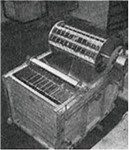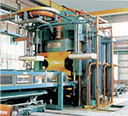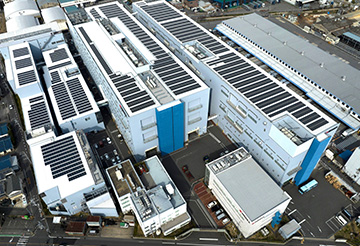Back in the days, when Japan relied on imports from the USA and Europe for most of industrial machinery, HISAKA succeeded in developing Japan's first dyeing machines, plate heat exchangers (PHEs) and ball valves, using its own original technology.
As a global specialist manufacturer possessing technology to control the heat and pressure of fluids, we have created many products that are "No. 1" in various ways - first in Japan, first in the world, largest in the world and so on, with "sophisticated manufacturing technology" as our basis.
We will be keeping up that spirit of development for future challenges in advanced manufacturing.

The origin of HISAKA goes back to Mitsuishi Industries, founded by Kiyoshi Ishikawa in May of 1942. It was established with expectations regarding the wartime demand for the repair and restoration of machine tools, with its factory in Higashiyodogawa of Osaka City. Just a year after its establishment, however, the short-lived Mitsuishi Industries was aggregated into a new company established by order of the Ministry of Supply. Then, it was inherited by Harunobu Miura and Shizuo Nanba, two men Ishikawa met through work. Miura and Nanba were focused on "stainless steel," considered a valuable item at that time, and in November of 1946, they began manufacturing stainless steel pipes. In April of 1947, the company restarted as Sakura Works.
Miura and Nanba hit the mark, and the company became extremely busy, so much so that simply placing an ad for a processing manufacturer of stainless steel pipes resulted in orders the next day. At this time, in 1948, Fukuichi Ieki entered the company as a director. Sales grew smoothly and human resources, equipment, and products came into place. The foundation needed for a manufacturer was steadily developed. When President Miura went independent in 1951, new top management (President Ieki, Senior Director Nanba, Executive Yokoyama) was selected. Taking the symbols 日 ("Hi") from 日本 (Japan) and 阪 ("Saka") from 大阪 (Osaka), the company was renamed HISAKA WORKS, LTD. with hopes that the company would be as vibrant as the city of Osaka.
The design combines the symbol 日 from 日本 (Japan) and the letter S for "stainless." With a round shape that symbolizes maturity, the emblem contains the desire that each product made by HISAKA will take on the rich humanity of the HISAKA members as it grows to maturity.
 Company emblem
Company emblem
 First EX-2 delivered equipment and plate.
First EX-2 delivered equipment and plate.
In 1954, the company began developing plate heat exchangers (hereinafter, "PHEs"), and after a development period of two years, delivered the first EX-2 model, lovingly nicknamed the "Takoyaki Plate," in 1956. This was the beginning of HISAKA's PHE history.
Beginning with a cloth-dyeing machine, that used a wincing wooden tank lined with a thin stainless-steel plate, in 1958, HISAKA developed high-temperature, high-pressure yarn dyeing and finishing machines that incorporated HISAKA's original concepts, displaying products at the "first international trade fair" (Osaka). This led to the company being known on the market as "HISAKA for dyeing machines."
 Wooden tank with stainless-steel-lined wince
Wooden tank with stainless-steel-lined wince
 Japan's first ball valves
Japan's first ball valves
Then, using our unique stainless-steel processing technology, we developed Japan's first stainless-steel ball valves (2- and 3-way), thus becoming known as "HISAKA for special valves."
Kurakichi Takahashi became the new president with the goal of reforming management, and in 1959, the four business divisions layout was started, comprised on the "Heat Exchanger Department," "Chemical Machinery Department," "2nd Plant Department (later Special Products Department)," and "Dyeing Machines Department." Despite purchasing an idle plant in Higashiyodogawa to establish the Horiage Plant (former Yodogawa Plant), the company could not keep up with increasing orders, so in 1961, the Konoike Plant began construction and then started operating the following year.
Having participated in the 1960 "Japanese industrial exhibition" (Moscow), HISAKA received inquiries for dyeing machines from the former Soviet Union, and after a year of negotiations, reached an agreement for a large order totaling 740 million yen, including large dyeing and finishing machines (the annual sales at that time was 1.1 billion yen).
 Delivered to the factory in former Soviet Union.
Delivered to the factory in former Soviet Union.
1965 set a record for the highest number of company bankruptcies since the end of the war, and HISAKA also was in the red for the first half of 1964. In this situation, Shizuo Nanba became president, and the "first-phase 3-year plan," starting in 1966, was established. In order for HISAKA to become a global manufacturer of "heat and dyeing," the plan required "advanced technical direction," "extensive financial content," "more healthy relationships between labor and management," "fair personnel affairs," and "high salary levels," and various plans were made. One could say that this was the moment that HISAKA defined its path forward. At this time, the company also reorganized its business units, reviewed the relationship between labor and management, improved the relationship with cooperating companies (HISAKA Association), and established the company motto and management principle, truly taking shape as a company.
 Company Motto - "Sincerity"
Company Motto - "Sincerity"
"Sincerity (Magokoro)" shows our basic philosophy as a company and as company employees, that is, "Let's be a company that is trusted by society through providing it with products that are free of untruths and artifice. Thereby, let our members discipline and improve themselves and each other."
Riding the wave of economic recovery, the three businesses of dyeing machines, PHEs, and ball valves became firmly established in their markets. In the "second-phase 3-year plan" from 1969, a 20,000-ton press was installed as the basis for PHE manufacturing, and in 1971, the company successfully became listed on the Second Section of the Osaka Securities Exchange market.
 20,000-ton press
20,000-ton press
The "fourth-phase 3-year plan" saw the arrival of the second oil crisis. However, supported by private-sector capital investment that prioritized new products and energy-saving measures, the company recorded sales of 14.66 billion yen, 158.3% of the plan, in the final fiscal year. As one of the main features of the "K-81 plan," which was drafted as a plan to remodel konoike Plant, the largest 40,000-ton press in the world (and the second of its kind in the world) began operation in 1983, marking the first step towards "a global HISAKA (heat exchangers)." The company was listed on the Second Section of the Tokyo Stock Exchange market in 1985 and then on the First Section of market (Tokyo, Osaka, Nagoya) in 1987, succeeding in the long-sought goal of being listed on the First Section of the Tokyo Stock Exchange market.
 40,000-ton press
40,000-ton press
Understanding the changes and signs of the times, in 1987, the company started engaging in the long-term management concept "F21," which laid out the "ideal form of HISAKA for the 21st century." The following six years were a period of growth that stands out even in HISAKA's history. Through efforts utilizing the company's collective performance, such as putting the new model of the "Circular RZ" on the textile processing industry and promoting sales to overseas market, proposing and successfully putting on the market automated cheese (yarn dyeing) plants, expanding into the food and pharmaceuticals markets by developing a spray-type pouch-food sterilizer, introducing the food sterilizing PHE "FX Series" and the air conditioning "SX Series," and making our valves and actuators more compact, HISAKA achieved sales exceeding 24.5 billion yen in 1992.
 Circular Rapid (dyeing machine), high temperature and high pressure sterilizer for pharmaceutical use
Circular Rapid (dyeing machine), high temperature and high pressure sterilizer for pharmaceutical use
Following the series of events in which the economic bubble burst, which was a turning point for the Japanese economy, the Dyeing & Finishing Machines Department (currently the Process Engineering Division, "PE" hereinafter) experienced continuing stagnation in sales, along with decline of the Japanese textile industry. Despite this, the Heat Exchanger Department (currently the Heat Exchanger Division) successfully developed the "UX-100," the world's largest PHE, and in 1999, carried out the "K-99 plan (Konoike remodeling plan)," finishing a new wing and the 4,000-ton press line. The Food Machines Department (currently the PE Division) also achieved steady orders and contributed to the increase in sales through the development of a high-temperature rapid cooking sterilizer (RIC).
During the five years from the fiscal year ending March 2000 which was at our worst until 2004, the company was forced into harsh business management. With its very survival on the line, the company establish the "R-3 year plan" / "R-02" plan, and with a new organization led by President Shoichi Hayashi, moved forward with reconstructing its business. The three years of "R-02" were used as preparation to move onto the next breakthrough. As the main feature, the "Konoike master plan" was announced in 2004.
 Newspaper articles dated 04/06/2004, 05/13/2004, and 05/31/2004
Newspaper articles dated 04/06/2004, 05/13/2004, and 05/31/2004
In order to establish PHEs in southeast Asia, the company decided to switch from conventional agent sales to HISAKA market expansion and local manufacturing / assembly. The company gradually developed a foothold in southeast Asia, establishing HISAKAWORKS S.E.A.SDN. BHD. in 2004, HISAKA WORKS (THAILAND) CO., LTD. in 2007, HISAKAWORKS SINGAPORE PTE. LTD. in 2009, and a representative office in Indonesia (currently PT. HISAKA WORKS INDONESIA) in 2011. Also, in order to establish itself in the Chinese market and to improve price competitiveness, the company established HISAKA (SHANGHAI) TRADING CO., LTD. (currently HISAKA WORKS (CHINA) CO., LTD., SHANGHAI BRANCH) in 2006 and HISAKA WORKS (CHANGSU) CO., LTD. (currently HISAKA WORKS (CHINA) CO., LTD.) in 2009. Furthermore, as plant exports to the Middle East increased, the demands for maintenance service from users also increased, leading to the company establishing HISAKA MIDDLE EAST CO., LTD., a joint venture, in 2012. The following year, in 2013, the company established HISAKA KOREA CO., LTD. In Korea as a sales location in order to further expand orders.
 Maintenance plants in S.E.A., HISAKA (CHINA), and HISAKA ME (Saudi Arabia) when they were established
Maintenance plants in S.E.A., HISAKA (CHINA), and HISAKA ME (Saudi Arabia) when they were established
Holding the "R-05" plan as the "second foundation period," the company aimed to expand business, calling for "a shift from surviving to winning." Luckily, the domestic market began recovering in FY2005, and the three years of "R-05" saw new records for increased orders. The company recorded 34.65 billion yen in the final fiscal year of 2008, successfully doubling in growth over six years. In order to achieve higher productivity by consolidating common manufacturing technology and spur the development of new products by putting together the common technical development capability, the whole company was consolidated at the Konoike Plant in March of 2008. Completion through the master plan took four years and ended up in a big project with a total cost of 18.78 billion yen for construction.
In order to enable provision of products across a wide range of fields as well as contribute to the development of new products, the company acquired as subsidiaries MICROZERO in 2009, ASAHI INDUSTRY in 2016 and KOMATSUGAWA CHEMICAL ENGINEERING in 2019. (*MICROZERO and ASAHI INDUSTRY merged to form HISAKA PRODUCTS in 2023.) Also, our sales unit, which had covered all of Japan with two sales locations in Osaka and Tokyo, opened a Nagoya Branch Office in 2014 in order to strengthen sales and increase brand recognition in the Chubu and Tokai areas, and also opened the Kyushu and Kitakyushu Branch Offices in the following year of 2015 in order to strengthen sales and improve service in the Kyushu area.

To promote the use of environmentally friendly “Renewable Energy," 2,324 solar panels were installed on the roof of Konoike Plant in 2014, and HISAKA began selling the electricity generated. (maximum power generation capacity: 500kW; annual power generation: 660,000 kWh; planned annual CO₂ reduction: 226 tons). In addition, the solar power generation equipment installed in 2022 is contributing to further reduction of greenhouse gas emissions by consuming all electricity generated within the plant (251.8 kW generated; planned annual CO₂ reduction: 127 tons).

In 2016, HISAKA formulated its vision for 100th anniversary is "to become a company that puts together control technology for fluid heat and pressure to support the future of energy, water, and food with our customers", and target sales were set at 100 billion yen in group sales. The "New Business Promotion Department" was established in 2018 to explore and promote the commercialization of new businesses and products.
In 2021, HISAKA established "HISAKA MIND," a set of common values for all employees consisting of the Company Motto, Business Creed, Five Principles, and Action Guidelines, by employee participation. In addition, the "Hisashiru Activity," which stands for "activities to let more people know about HISAKA," was launched, and the first corporate message “with hopeful technology", was formulated.

To meet the growing demand for production facilities and engineering for food, pharmaceuticals, and other products, HISAKA acquired a business site in Ikoma City (Nara) in 2019 and began construction of the Ikoma Plant. In 2024, Process Engineering Business moved from Konoike Plant to new Ikoma Plant and has been working to increase production capacity and establish a highly efficient production system by installing state-of-the-art buildings and equipment.

Looking ahead to its 100th anniversary in 2042, while it is difficult to imagine, HISAKA assuredly focuses on future ahead, thus promoting unconventional ideas and accelerating HISAKA's comprehensive strength and future creativity in order to embody the ideal HISAKA WORKS, that is, "a company that puts together control technology for fluid heat and pressure to support the future of energy, water, and food together with our customers."